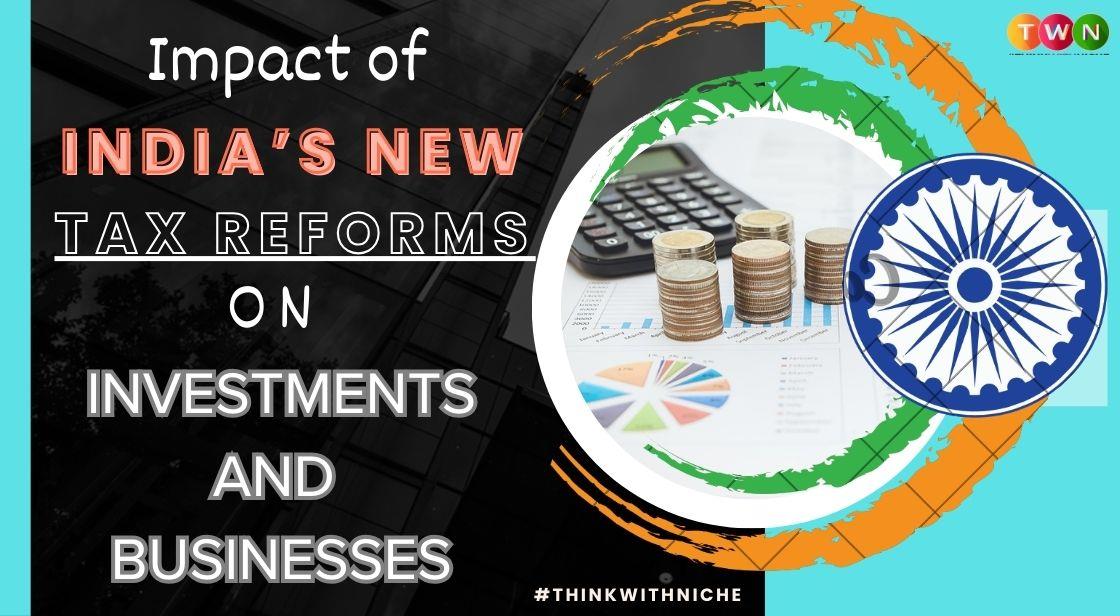Impact of India’s New Tax Reforms on Investments and Businesses

Blog Post
India’s economic growth trajectory has been accelerating in recent years, with tax reforms playing a crucial role in shaping its investment landscape.
From the introduction of the Goods and Services Tax (GST) to the rationalisation of corporate tax rates and the upcoming New Income-tax Bill, 2025, India has taken significant steps to modernise its taxation system.
These reforms have not only simplified compliance for businesses but also enhanced the country’s global competitiveness, making it one of the most attractive investment destinations.
According to government data, India attracted $42.1 billion in Foreign Direct Investment (FDI) in the first half of FY 2024–25, reflecting a 26% year-on-year increase, despite global economic headwinds.
This underscores investor confidence in India’s business environment, which continues to improve through progressive tax reforms, digitisation, and sector-specific incentives.
In this article, we explore how India’s evolving tax structure is reshaping its business ecosystem, boosting investor sentiment, and positioning the nation as a global hub for innovation and growth.
How Tax Reforms in India Are Driving Growth and Investments
India's economic landscape is undergoing a significant transformation, driven by a series of bold and forward-looking tax reforms. These changes, from the landmark Goods and Services Tax (GST) to the rationalization of corporate taxes and the comprehensive New Income-tax Bill, 2025, are fundamentally reshaping the country's business environment.
The government’s vision is to create a stable, transparent, and competitive tax system that not only simplifies compliance but also actively attracts long-term investment.
This article explores the evolution of these reforms and their profound impact on both domestic and international investors and businesses.
A New Era of Taxation: Evolution and Modernisation
India’s taxation system has evolved considerably since the Income Tax Act of 1961. The recent reforms represent a paradigm shift towards a digitized, transparent, and simplified framework. These changes are designed to foster an environment of trust and predictability, crucial for attracting capital.
Goods and Services Tax (GST): A Unified Market
Launched in 2017, the GST was a game-changer, replacing a fragmented system of multiple central and state taxes with a single, unified tax. This move has had a transformative effect on the economy:
-
Simplified Tax Structure: It consolidated a myriad of indirect taxes, such as VAT, excise duty, and service tax, into one comprehensive tax, making compliance much simpler for businesses.
-
Single National Market: By eliminating state-specific tax barriers, GST has created a unified national market, streamlining interstate trade and significantly reducing logistics and warehousing costs.
-
Streamlined Supply Chains: The ability to claim a set-off credit on taxes paid at previous stages has eliminated the cascading effect of taxes, boosting the efficiency of supply chains across all major industries.
Also Read: Indian Economy in Focus-FY25 Q4 Recovery Sparks Fresh Growth Hope for FY26
Corporate Tax Rationalization: Enhancing Global Competitiveness
To attract investment and stimulate economic activity, the government has aggressively rationalized corporate tax rates.
Major Tax Cuts:
In 2019, India reduced its corporate tax rate to 22% for domestic companies, with a further reduction to 15% for new manufacturing ventures. These rates are now among the most competitive in Asia, positioning India as a highly attractive destination for global businesses.
Boost for the 'Make in India' Initiative:
The lower tax rates for new manufacturing units have given a significant push to the government's flagship 'Make in India' campaign, encouraging both domestic and foreign companies to set up production bases in the country.
Continuous Modernization: Digitization and Trust
The ongoing digitization of tax processes has been a cornerstone of the reform agenda.
-
Faceless Assessments: The introduction of faceless assessments, online scrutiny, and digital appeals has minimized human intervention, reducing the scope for corruption and improving the overall fairness of the tax system.
-
Faster Compliance: Businesses can now complete a range of tax processes, from e-filing to e-verification, quickly and transparently, leading to a more efficient and predictable regulatory environment.
The New Income-tax Bill, 2025: A Forward-Looking Framework
The New Income-tax Bill, 2025, is a landmark legislative overhaul that aims to replace the more than 60-year-old Income-tax Act of 1961. It is designed to be a simpler, more modern, and equitable framework.
-
Simplification and Clarity: The Bill significantly reduces the number of sections from over 800 to 536 and consolidates provisions to minimize litigation and make the law more accessible to taxpayers.
-
Modern Economic Alignment: The new law recognizes and integrates modern economic realities, such as bringing Virtual Digital Assets (VDAs) like cryptocurrencies and NFTs under the tax net as capital assets.
-
Administrative Efficiency: It introduces the concept of a "Tax Year" to simplify reporting and extends the time limit for filing updated returns from two years to four, providing taxpayers with more flexibility.
Middle-Class Relief and Consumption Boost
A key feature of the new income tax regime is the relief it provides to salaried and middle-income groups.
-
Higher Tax Rebate: The tax rebate under Section 87A has been increased to Rs 60,000, meaning individuals with a net taxable income of up to Rs 12 lakh will have no tax liability under the new regime.
-
Boost to Consumption: This increase in disposable income is expected to boost retail consumption and savings, which in turn fuels growth in sectors like fast-moving consumer goods (FMCG), real estate, and digital services.
-
Simplified Filing: The new tax regime, which is the default option, is designed for simplified tax filing without the burden of various exemptions and deductions.
Impact on Investment Growth and FDI
India's tax reforms have directly contributed to an improved business and investment climate, attracting a steady flow of capital.
Ease of Doing Business and Market Efficiency
Simplified tax structures and the unified GST have significantly improved India's ranking in the Ease of Doing Business Index. This has lowered barriers for both new and existing businesses, making India a magnet for investors seeking a more straightforward regulatory environment. The single national market enabled by GST has led to lower logistics costs and more efficient supply chains, giving businesses a competitive edge.
Robust FDI Inflows
Despite global economic uncertainties, India has witnessed a surge in foreign direct investment (FDI). According to recent data, India attracted $42.1 billion in FDI in the first half of FY 2024–25, a substantial 26% increase. This highlights the sustained confidence of global investors in India's economic fundamentals. The government has also liberalized FDI norms in key sectors like insurance and defense, further opening the doors for foreign capital.
Strategic Tax Incentives
India's tax framework offers targeted incentives to promote growth in strategic sectors.
-
SEZ and IFSC Benefits: Businesses operating in Special Economic Zones (SEZs) and the International Financial Services Centres (IFSCs) at GIFT City receive significant tax exemptions and streamlined regulations, positioning India as a global financial and business hub.
-
Startup and Innovation Ecosystem: The government provides a 3-year tax holiday for eligible startups within their first ten years of incorporation. Additionally, angel tax relief for DPIIT-recognized startups has made it easier for them to secure crucial early-stage funding, fostering a vibrant ecosystem for innovation and entrepreneurship.
-
ESG-Linked Incentives: In an emerging trend, the government is introducing tax incentives for green energy, electric vehicles (EVs), and decarbonization initiatives, aiming to attract impact investors and align with global sustainable development goals.
Tax Certainty and Future Prospects
To provide investors with greater predictability, India has strengthened its dispute resolution mechanisms through initiatives like Advance Rulings and Mutual Agreement Procedures (MAP). These measures reduce tax-related uncertainties for foreign investors, offering them the confidence to engage in long-term strategic planning.
India's tax reforms have laid a solid foundation for a more resilient, predictable, and investor-friendly economy. With a competitive tax structure, simplified compliance, and a strong focus on digital integration, India is poised to emerge as one of the world's most attractive destinations for long-term investments, offering a unique blend of market scale, stability, and sustained growth.
Conclusion
India’s tax reforms have moved far beyond revenue collection; they are now a cornerstone of the country’s investment strategy. By introducing competitive tax rates, transparent digital systems, and investor-friendly incentives, India has positioned itself as a leading global investment hub.
With GST unifying the market, corporate tax cuts enhancing competitiveness, and the New Income-tax Bill, 2025 promising modernisation, India’s tax landscape is evolving to meet both domestic and global demands. The growing alignment with ESG standards, startup support, and financial liberalisation further strengthens India’s case as a destination for long-term, sustainable, and high-return investments.
As global investors seek stability, scale, and growth, India’s progressive tax reforms are ensuring that the country remains one of the most promising economic frontiers of the next decade.
You May Like
EDITOR’S CHOICE












